10 Buildings In The World Inspired By The Sails Of A Ship
Buildings and ships have one thing in common. Do you know what it is? Well, modern constructions and ships are designed to serve two main purposes. They should be functional and energy-efficient. A great design and visual appeal are the cherry on the cake.
Nowadays, buildings also represent the cultural heritage of the place they’re built in. They are sometimes symbolic and are reflective of the architect’s inspiration.
In this article, let us look at ten iconic buildings that are inspired by the sails of a ship.
1. Burj Al Arab – Dubai, United Arab Emirates
The Burj al Arab, also known as the Tower of the Arabs, is a luxurious hotel building located on an artificial island approximately 300 metres from Jumeirah Beach, Dubai, UAE. It is 321 metres tall and is the 3rd tallest hotel building in the world. It is also said to be one of the most expensive, dripping luxury and opulence.
However, what makes it a unique structure is its architectural style and inspiration. It was designed to reflect Dubai’s seafaring culture and heritage. An iconic construction, it mimics the shape of a modern yacht’s sail.
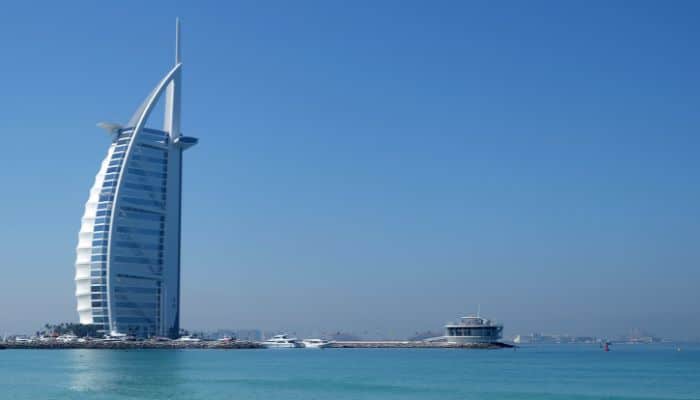
Burj al Arab was constructed at a time when Dubai enjoyed prosperity from oil revenues but decided to diversify its economic base by moving into sectors like luxury tourism and the development of the real estate. It was in 1993 the then-ruler of Dubai asked Atkins to construct a building that would imbibe the essence of the city.
Atkins, a British consultancy, was led by Architect Tom Wright, who designed a high-tech building resembling the sail of a traditional arab yacht or dhow.
2. The Quadracci Pavilion – Milwaukee, Wisconsin
The Quadracci Pavilion was added to the Milwaukee Art Museum. Designed by the famous Spanish architect Santiago Calatrava, it is a 142,050 sq foot building completed in 2001.
It has a reception room, a massive auditorium, a huge hall for holding exhibitions, a cafe and a parking space. The construction is an amalgamation of technology and age-old craftsmanship.
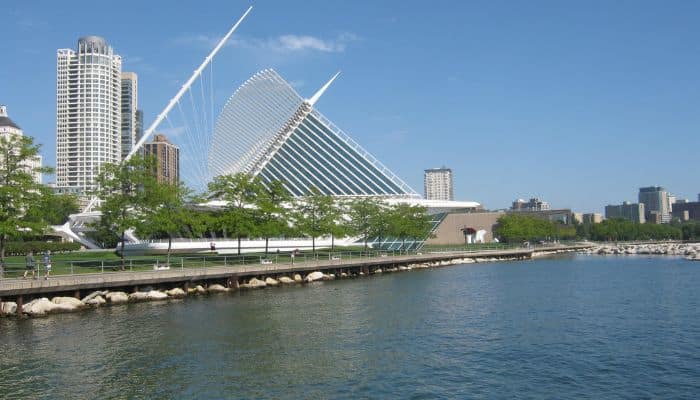
The architect took inspiration from the city’s topography, among other things, to build the graceful pavilion.
Its design is also inspired by its location, which faces the lake. Many maritime influences can be seen, such as the movable steel blinds, a pedestrian bridge having a mast which is inspired by the shape of sailboats and a curved gallery which mimics a wave.
The architect says that the pavilion symbolises the lake’s culture, the sailboats, the city’s weather and the idea of movement and change.
3. IAC Building – New York
The IAC Building in Manhattan, New York, is undoubtedly elegant. It was designed by Canadian-American architect Frank Gehry. The construction started in 2004 and ended in 2007.
It was the architect’s first project in New York and had the world’s biggest HD screen at that time.
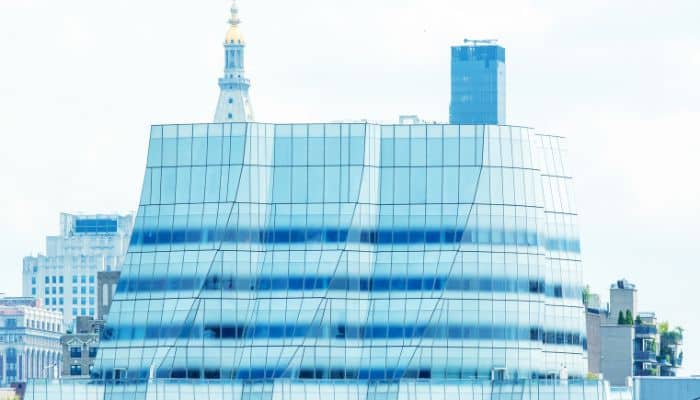
The 44 m high building has 10 floors but has been designed so that it looks to have two levels.
The building looks like the sails of a sailboat or can even be imagined as an ocean wave or the pleats of a skirt. However, the inspiration for it came from the former.
The building seems different when seen from different angles. As one views it from the north, it looks symmetrical, having sharp edges. From the south, it appears blocky. The sail-inspired curves of the west facade look beautiful against the passing vehicles.
4. Kobe Maritime Museum – Kobe, Japan
Kobe Maritime Museum is a modern construction and reveals the rich history of Kobe as an important port city and the Japanese shipping industry.
It was constructed to celebrate the 120th anniversary of opening Kobe as a foreign port in 1868, the end of the Edo dynasty.
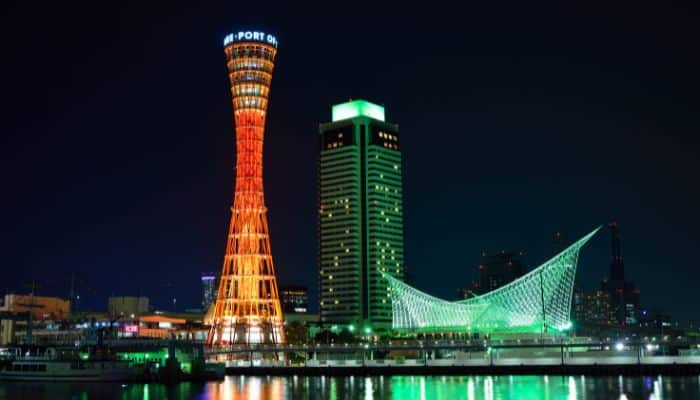
The museum’s exterior resembles the sails and rigging of a sailing vessel. The museum has displays of famous trading vessels and merchant ships. The majority of the displays are small, and one can see different types of boats and ships here.
The famous Royal Navy ship, HMS Rodney’s model, can be seen here. Another famous model is the ship Yamato I.
The unique character of this museum and its perfect location at the river near the city makes it a must-visit spot for lovers of nautical history. Also, its concept highlights a sensitivity towards the city’s other buildings, as the contemporary architecture stands out yet blends perfectly with the landscape.
5. Canada Place – Vancouver, British Columbia
Canada Place is an important building located on Burrard Inlet. It serves as the region’s main cruise terminal and houses the Vancouver Convention Centre and Pan Pacific Vancouver Hotel. The famous FlyOver Canada is also situated here.
The exterior of the building is made of roofs covered with fabrics which look like a ship’s sails. One can reach the building through the SkyTrain line at the Waterfront Station Terminus. Another way is through West Cordova Street.
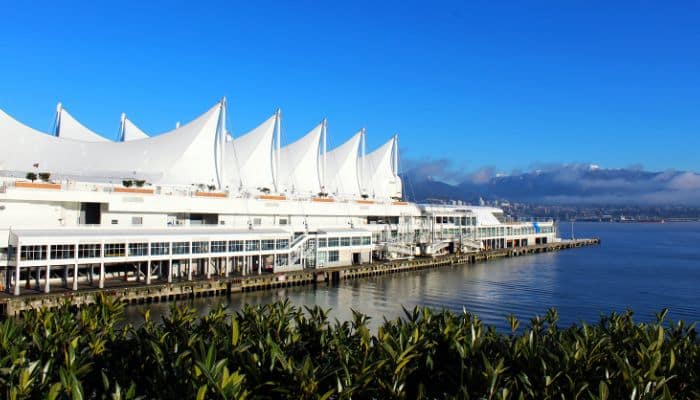
The building was expanded to add one more cruise birth in 2001. In 2009-10, it functioned as the press centre during the Winter Olympics.
It is a happening place crowded with tourists, offering beautiful ocean views, shopping centres, eateries and beautiful decorations on holidays.
6. NV Buildings – Salford, United Kingdom
The NV Buildings are huge residential structures constructed to restore the beauty of Salford Quays. Their curved design represents the area’s maritime history, and their design resembles wind-swelled sails.
Designed by Broadway Maylan, the three buildings were constructed from 2004-2005 and are 180 ft tall. Salford Quays was an urban regeneration project on old Manchester Docks near the Manchester ship canal’s end.
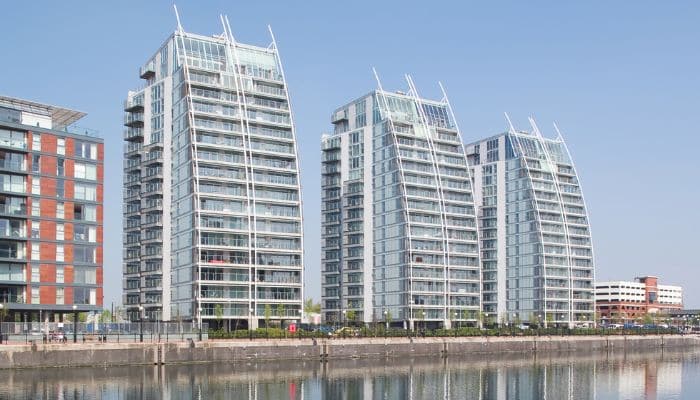
The area was run down due to the declining use of the canal but was reborn with the project, the construction of many residential and commercial structures.
Apart from houses and buildings, it also houses the Lowry arts and leisure centre, the Lowry Outlet Mall and Imperial War Museum.
Salford Quays is a famous tourist spot. People come to see the buildings and enjoy the solitude along the waterfront. Various events like triathlons and swimming competitions are hosted all year round.
7. Marina Bay Sands Hotel – Singapore
The Marina Bay Sands Hotel is a famous building in Singapore which blends modern design with natural elements. It is not only visually appealing but also a sustainable construction.
It was designed by Moshe Safdie, a renowned architect, with three 55-storey towers connected by a vast rooftop terrace supported by steel columns. The hotel is a unique construction with a ship-like structure on the top called the SkyPark.
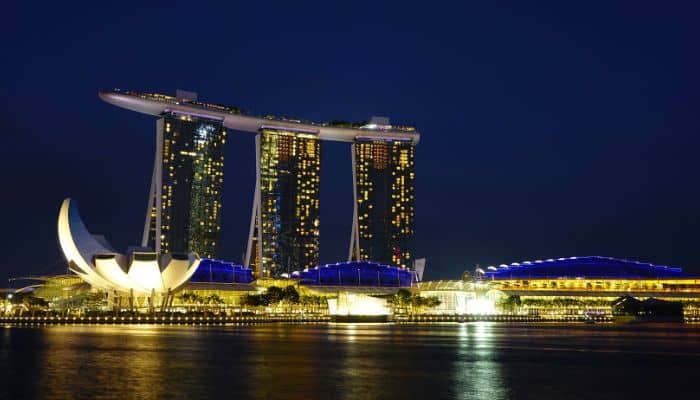
It is 340 m long and has an infinity pool, the world’s biggest rooftop pool, with a garden, observation deck, restaurants etc.
The hotel has become a popular tourist attraction and has been featured in several movies and television shows. It is also a recipient of many awards due to its innovative and functional design.
The SkyPark’s design was inspired by terraced rice paddies, making a lush green oasis amidst the city. It can collect and reuse rainwater, and the facades of the building are made of energy-efficient glass.
8. Sydney Opera House – Sydney, Australia
The Sydney Opera House, designed by Jorn Utzon, is one of the most captivating buildings in the world. It is known for its attractive roof that looks like soaring, shell-like sails. The inspiration for this structure was the architect’s childhood memories of sailing and shells found on beaches.
Its architecture is compared to a ship due to its unique design, which looks like it is floating on the Sydney Harbour. The design of the Opera House was selected from more than 200 entries in a competition held in 1956, and the construction started in 1959.
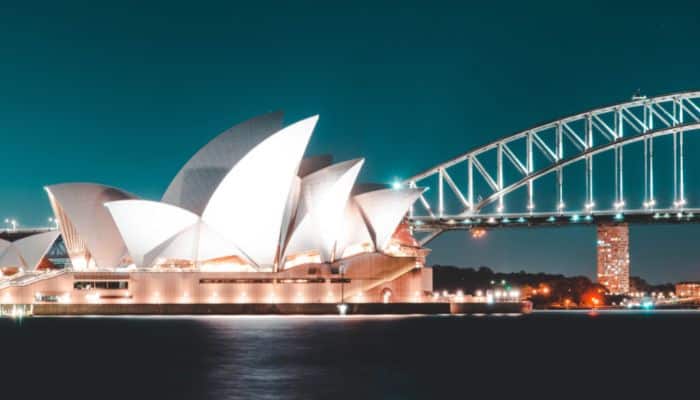
It took more than 14 years to complete, and during that period, many changes occurred, and the project saw the resignation of the architect in 1966.
Overcoming all odds, the Sydney Opera House stands and awes thousands of people that visit the place annually. Its beautiful sails are made of precast concrete and layered with a million white tiles.
It has many theatre and performance spaces to host operas, concerts, conferences and ballets. The concert hall can accommodate 2500 people and the opera theatre around 1500.
Located at a place with strong tidal currents, the building sits on several concrete piers to support the weight and withstand water and wind forces.
9. National Bank of Dubai, Dubai, United Arab Emirates
The National Bank of Dubai is popularly known as the ‘ship building’ or ‘sailing ship’ due to its design that looks like the shape of a vessel’s hull. It was designed by Carlos Ott and completed in 1999.
It portrays the maritime history of Dubai and its importance as a centre of trade and commerce in the world. Its curved shape and blue glass facade appear like a hull, while the sail-like design on its roof depicts the nautical influence. It is located next to Dubai Creek, which adds to the city’s maritime history.
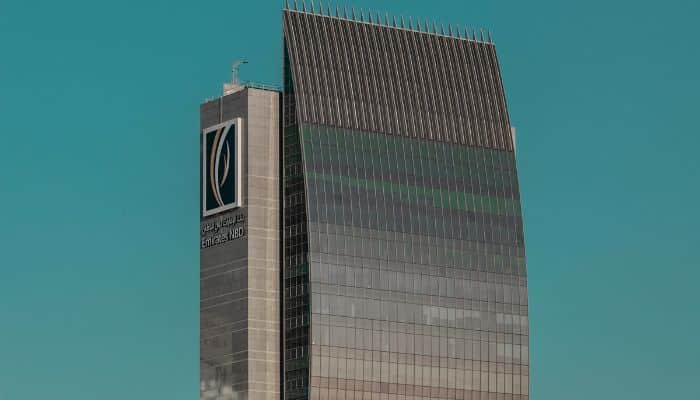
The building represents a sense of mobility and fluidity. It is also known for its size as it is 125 metres high and has 21 floors, which made it one of the tallest buildings in the city when it was built.
It is a perfect blend of modern architecture and an inspirational design symbolic of Dubai’s cultural heritage.
10. National Theatre, Hungary
The present-day building of the National Theatre of Hungary was opened in 2002. It is situated in the Palace Quarter, Budapest and has a distinct design that some think resembles a ship. It was designed by architect Maria Siklos.
The inspiration came from a vessel sailing elegantly on the river Danube that goes through Budapest.
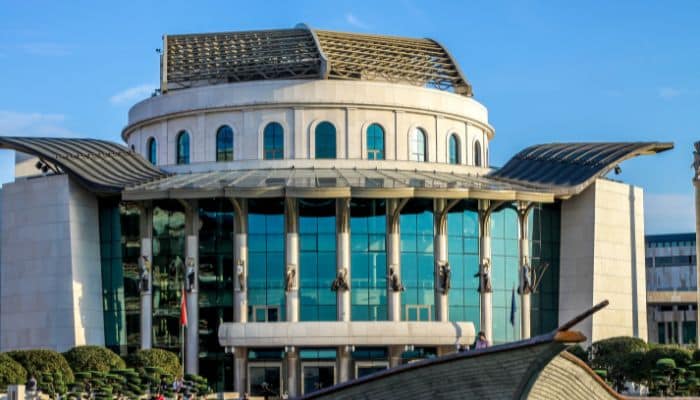
Its exterior is composed of white marble, and the building’s curved shape looks like a ship’s bow. Its interiors are spacious, and it has high-tech features. It has three stages: the Main Stage, Chamber Stage and Studio Stage. It can accommodate 619 people at once.
The National Theatre of Hungary has won many awards and has an eye-catching design that has made it one of the most visited places in Budapest who come here and appreciate its architectural style and performances.
You might also like to read-
- 10 Ship Terms And Definitions Even Smart People Misuse
- Top 11 Mysterious Ghost Ships and Haunted Stories of the Maritime World
- 10 Important Organizations Seafarers Can Contact For Help
- 7 Most Common Superstitions of Seafarers
- What are Sea Shanties?
Disclaimer :
The information contained in this website is for general information purposes only. While we endeavour to keep the information up to date and correct, we make no representations or warranties of any kind, express or implied, about the completeness, accuracy, reliability, suitability or availability with respect to the website or the information, products, services, or related graphics contained on the website for any purpose. Any reliance you place on such information is therefore strictly at your own risk.
In no event will we be liable for any loss or damage including without limitation, indirect or consequential loss or damage, or any loss or damage whatsoever arising from loss of data or profits arising out of, or in connection with, the use of this website.
Do you have info to share with us ? Suggest a correction
Disclaimer :
The information contained in this website is for general information purposes only. While we endeavour to keep the information up to date and correct, we make no representations or warranties of any kind, express or implied, about the completeness, accuracy, reliability, suitability or availability with respect to the website or the information, products, services, or related graphics contained on the website for any purpose. Any reliance you place on such information is therefore strictly at your own risk.
In no event will we be liable for any loss or damage including without limitation, indirect or consequential loss or damage, or any loss or damage whatsoever arising from loss of data or profits arising out of, or in connection with, the use of this website.

About Author
Zahra is an alumna of Miranda House, University of Delhi. She is an avid writer, possessing immaculate research and editing skills. Author of several academic papers, she has also worked as a freelance writer, producing many technical, creative and marketing pieces. A true aesthete at heart, she loves books a little more than anything else.
Latest Maritime Knowledge Articles You Would Like:
Subscribe To Our Newsletters
By subscribing, you agree to our Privacy Policy and may receive occasional deal communications; you can unsubscribe anytime.















